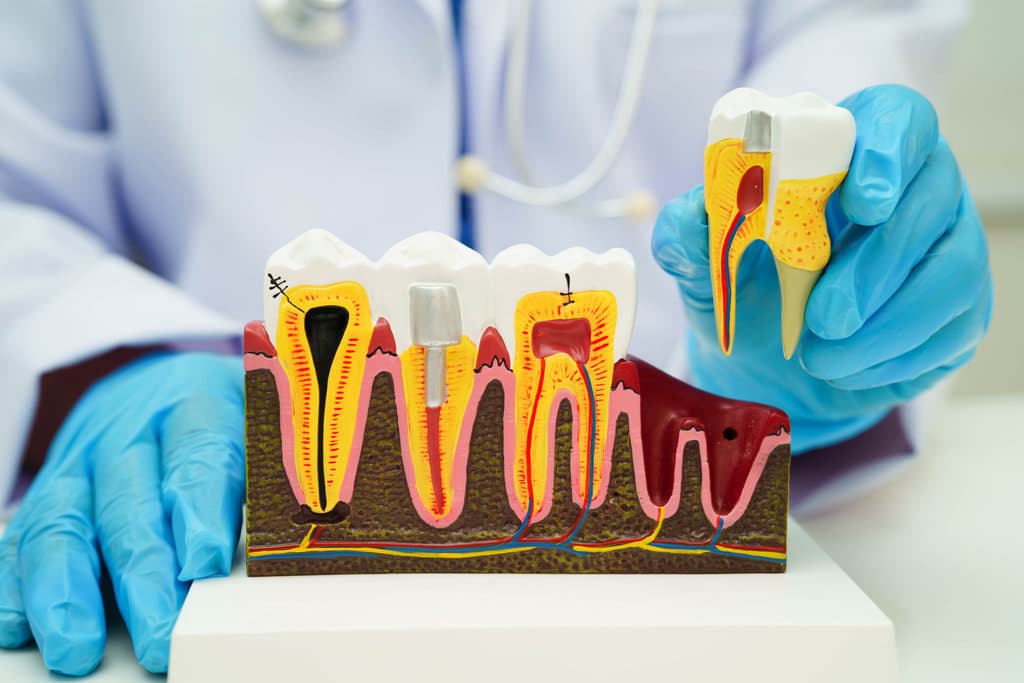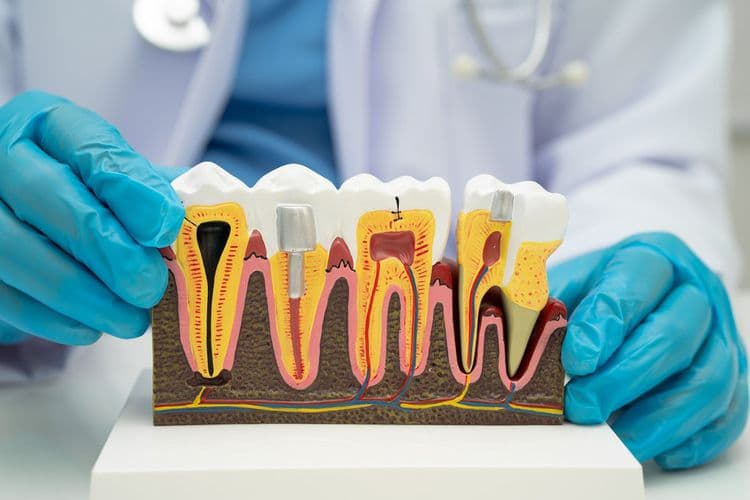Root canals and dental implants are essential in modern dentistry, each serving distinct roles in oral rehabilitation. Root canals aim to preserve the natural tooth structure by removing infected pulp, while dental implants replace missing teeth with a prosthetic alternative. Both procedures boast high success rates and durability, yet they differ in indications, costs, and procedural steps. Understanding these differences is vital for selecting the most appropriate treatment for tooth damage or loss.
Understanding Root Canals
Understanding root canals requires an exploration of the intricate procedures involved in endodontic therapy, where the primary objective is to preserve natural teeth by removing infected or damaged pulp tissue. The root canal benefits include the elimination of infection, prevention of further dental deterioration, and maintenance of the tooth’s natural function. From a clinical perspective, patient experiences reveal significant symptom relief post-procedure, with success rates exceeding 95% in most cases, according to evidence-based studies. The process involves careful removal of necrotic tissue, disinfection of the root canal system, and obturation with biocompatible materials to prevent recontamination. This treatment option is often preferred due to its ability to restore oral health and function, minimizing the need for tooth extraction and subsequent prosthetic interventions.
Exploring Dental Implants
When considering the ideal solution for tooth loss, how do dental implants compare to traditional alternatives? Dental implants provide a prosthetic solution that mimics natural tooth functionality and aesthetics. The primary dental implant benefits include osseointegration, which enhances stability and prevents alveolar bone resorption. Implant types vary, offering tailored solutions: endosteal implants, the most common, are surgically placed in the jawbone, while subperiosteal implants sit on top of the jawbone, beneath the gum tissue, suitable for patients with inadequate bone height. Evidence indicates high success rates and longevity, often exceeding those of conventional bridges and dentures. Clinicians must assess individual anatomical and medical factors to determine the best implant types, maximizing patient outcomes through personalized treatment plans.
Indications for Root Canal Treatment
Root canal treatment is indicated primarily in the presence of symptomatic irreversible pulpitis or pulp necrosis, often characterized by persistent pain, prolonged sensitivity to thermal stimuli, and spontaneous toothache, as evidenced in clinical studies. Etiologically, pulp damage can result from dental caries, traumatic injury, or repeated dental procedures, leading to inflammation or infection of the dental pulp. The treatment procedure involves the removal of the infected or necrotic pulp tissue, followed by cleaning, shaping, and obturation of the root canal system to restore the tooth’s function and prevent further microbial invasion.
Tooth Infection Symptoms
How can one identify the need for root canal treatment? Clinical indicators often include persistent toothache caused by infection or inflammation of the dental pulp. This pain may be exacerbated by thermal stimuli or occlusal pressure. Swelling gums surrounding the affected tooth may also manifest, suggesting the presence of periapical abscesses or periodontal inflammation. Radiographic imaging can reveal periradicular radiolucency, indicative of necrotic pulp tissue and bacterial invasion. Additionally, palpation and percussion tests may elicit tenderness, further corroborating the diagnosis. Advanced cases might present with sinus tract formation or purulent discharge. A systematic assessment, employing both clinical evaluation and diagnostic imaging, is essential for determining the necessity of endodontic intervention to alleviate symptoms and prevent further dental or systemic complications.
Pulp Damage Causes
Persistent toothache and associated symptoms often signify underlying pulp damage necessitating endodontic intervention. Pulp inflammation causes primarily include untreated dental caries and trauma, both of which facilitate bacterial invasion into the pulp chamber. Carious lesions compromise enamel and dentin, allowing pathogens to penetrate and inflame the pulp. Trauma, such as a fracture or impact injury, may disrupt blood supply, precipitating inflammatory responses. If untreated, inflammation can progress to pulp necrosis, wherein irreversible damage occurs. Pulp necrosis factors encompass prolonged exposure to irritants, ischemia, and extensive microbial colonization. The necrotic pulp becomes a nidus for infection, potentially leading to periapical abscess formation. Early identification of these etiological factors is essential in determining the need for root canal therapy to preserve tooth integrity.
Treatment Procedure Overview
Endodontic therapy, commonly known as root canal treatment, is indicated when the dental pulp becomes irreversibly damaged or infected. This clinical decision is substantiated by symptoms such as persistent pain, prolonged sensitivity to thermal stimuli, or radiographic evidence of periapical pathology. Treatment comparison with dental implants reveals that root canals preserve the natural tooth structure, aligning with patient preferences for minimally invasive interventions. In addition, root canal treatment is often favored when the tooth is structurally sound, lacking significant periodontal compromise. Evidence-based guidelines suggest that timely endodontic intervention can effectively prevent the progression of infection, thereby maintaining oral health. Patients often opt for root canals due to their shorter recovery period and familiarity with the procedure, highlighting a preference for retaining natural dentition.
Situations Ideal for Dental Implants
In cases where a tooth is severely damaged or missing, dental implants present an ideal solution, especially when other restorative options are insufficient. Ideal candidates for dental implants typically include individuals with adequate bone density and volume to support the implant fixture. Implant benefits encompass enhanced masticatory function, improved esthetics, and preservation of adjacent teeth, as implants do not require alteration of neighboring structures. Clinically, dental implants demonstrate superior longevity and success rates, with evidence suggesting a 95% survival rate over ten years. They are particularly advantageous in edentulous patients or those with single-tooth loss where conventional prosthetics might compromise oral health. The ability of implants to integrate with the osseous tissue underscores their efficacy as a long-term restorative solution.
Procedure Steps for a Root Canal
When a tooth’s pulp becomes infected or damaged, necessitating intervention, a root canal procedure becomes essential to preserve the natural tooth structure. The treatment steps commence with clinical and radiographic evaluation to confirm diagnosis. Local anesthesia is administered to guarantee patient comfort. The endodontist then employs a dental dam to isolate the tooth, maintaining a sterile field. An access opening is created in the crown to reach the pulp chamber and root canals. Using specialized instruments, the infected pulp tissue is meticulously removed. The canals are then shaped and irrigated with antimicrobial solutions to eradicate residual bacteria. Following thorough cleaning, the canals are obturated with biocompatible materials, typically gutta-percha. Finally, the access cavity is sealed with a temporary or permanent restoration.
The Process of Getting a Dental Implant
Although root canals aim to preserve a tooth, dental implants provide a solution when tooth extraction is unavoidable. The implant procedure involves several stages, beginning with the surgical placement of a titanium post into the jawbone, which acts as an artificial tooth root. Osseointegration occurs over several months, during which the bone fuses with the implant, ensuring stability. Once integration is confirmed, an abutment is attached to the implant, serving as a connector for the prosthetic crown.
Post surgery care is critical to the success of the implant. Patients must adhere to rigorous oral hygiene practices to prevent infection. Follow-up appointments are necessary to monitor healing and implant integration. Clinical studies demonstrate high success rates, contingent upon meticulous procedural adherence and effective postoperative management.

Comparing Costs: Root Canal Vs Implant
Cost analysis is paramount when evaluating root canals versus dental implants. Root canal therapy is generally less expensive, with costs influenced by procedural complexity and geographic location. Conversely, dental implants typically incur higher expenses, encompassing surgical placement, abutment, and crown, with distinct cost factors such as bone grafting if necessary. Insurance coverage plays a critical role in determining out-of-pocket expenses. While many policies cover root canal treatments under standard dental plans, coverage for implants is often limited, classified as cosmetic or elective. Consequently, patients may encounter significant financial responsibility for implants. An evidence-based approach necessitates consideration of long-term cost-effectiveness, factoring in potential subsequent treatments. Clinicians should provide transparent cost estimates, enabling informed decisions aligned with patient-specific financial and clinical needs.
Longevity and Durability of Each Option
In evaluating the longevity and durability of dental treatments, both root canals and dental implants present distinct profiles. Root canal therapy, often necessitated by endodontic infections, aims to preserve the natural tooth structure. Its longevity factors depend on the integrity of the remaining dental tissue and the success of sealing the canal. Clinical evidence suggests a success rate exceeding 90% over a decade. In contrast, dental implants, which replace missing teeth, offer a durability comparison with a high survival rate. Longevity is influenced by osseointegration, prosthetic load, and oral hygiene practices. Studies indicate implants maintain functionality for 15 to 20 years or more. Both treatments require periodic monitoring to address potential issues impacting their durability and long-term success.
Evaluating Risks and Complications
When considering the risks and complications associated with root canal therapy and dental implants, how do these two treatments compare? Root canal procedures generally involve risks such as persistent infection, tooth fracture, or procedural errors. Complication management focuses on re-treatment or surgical intervention if initial therapy fails. Conversely, dental implants present risk factors including surgical site infection, implant failure, and peri-implantitis. Effective complication management for implants requires rigorous post-operative care and potential surgical revision. Evidence indicates that both procedures exhibit varying degrees of success contingent on patient-specific factors such as oral hygiene, systemic health, and adherence to post-treatment care. Clinicians must weigh these risk factors when recommending treatment, ensuring favorable outcomes through personalized assessment and targeted complication management strategies.
Frequently Asked Questions
What Is the Recovery Time for a Root Canal Vs an Implant?
Recovery experience varies: root canal typically involves a shorter recovery, often within days, with manageable discomfort. Implant recovery extends weeks to months, requiring meticulous pain management due to surgical nature, osseointegration, and potential for complications.
Do Root Canals or Implants Require More Follow-Up Visits?
The follow-up frequency for dental procedures varies. Root canal treatment typically involves fewer visits, while implants may require more due to longer treatment duration, encompassing osseointegration and restoration phases, necessitating multiple clinical evaluations for ideal outcomes.
Can Dental Insurance Cover Both Root Canals and Implants?
Dental insurance coverage differences often determine eligibility for procedures. Coverage limits vary, with root canals generally receiving broader insurance support. Implants may face restrictions due to higher costs, resulting in partial coverage or exclusions depending on the plan specifics.
How Do Dietary Restrictions Differ After Each Procedure?
Post-procedure diet considerations emphasize minimizing food sensitivity. Following endodontic treatment, patients may experience temporary sensitivity to temperature extremes. Implant procedures necessitate a softer diet initially, gradually reintroducing firmer foods as osseointegration progresses, ensuring ideal recovery and restoration.
Are There Any Age Limitations for Root Canals or Implants?
Age factors play a critical role in determining patient suitability for dental procedures. While root canals can generally be performed on patients of all ages, implants typically require sufficient bone growth, often limiting them to older adolescents and adults.


